אזורי השפעה
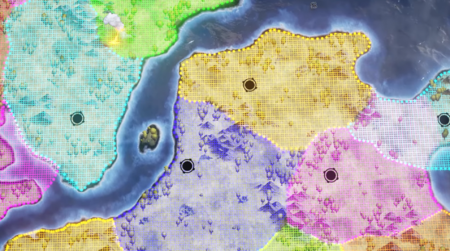
Every Node is given purview over a predefined geographic area called a Zone of Influence (ZoI). No matter where you go in the world, whether you’re questing, gathering, or raiding, you’ll be helping determine which nodes will develop, and what Zones of Influence will expand. Any area that a Node controls is considered its Zone of Influence, including Vassal Nodes, and all Vassal Nodes exist within the Zone of Influence of their Parent Node.[2] – Margaret Krohn
Every node is given purview over a predefined geographic area called a אזורי השפעה (ZOI). Player activity within the ZOI is weighted and counted toward a particular node’s advancement.[1]
The main thing that differentiates us from other MMOs is that we have a living, breathing, reactive world... Our world is separated into zones, which are then separated into what we call nodes. Nodes are sort of invisible zones of influence that listen to everything that a player does; so as players gain experience from killing things, gain experience from doing quests, gain experience through crafting things, the node is also gaining that experience. Once a node gains enough experience it levels up and then starts to attract NPCs to it .[3] – Jeffrey Bard
- By undertaking familiar activities, such as questing, gathering and raiding, players have agency in determining which nodes in the world will develop.[4]
Each Node can form into towns, but are limited by their neighbors. The Nodes have different levels of advancement. There can only be so many of each level. Think of this as advanced settlements needing more elbow room. Nodes encompass more land as they grow and will require more effort to be sustained. This system is a main driver for change in the world because it creates scarcity. As Nodes advance in stages of growth they will lock out neighboring Nodes from progressing, and will absorb their zones of influence.[1]
- Zones of influence connect fully across the world without any gaps.[5]
There is not a space where you will move in to do something and no node will get that experience.[5] – Steven Sharif
- Underrealm nodes and nodes directly above them are considered adjacent but do not exist in the same אזור השפעה.[6][7][8]
- Up to one fifth of the world will be encompassed within the אזור השפעה of a מטרופולין. The many vassal nodes within a ZOI's "border" could end up looking like a country or nation.[9]
שלבי צומת
צמתים מתפתחים על ידי איסוף של נקודות ניסיון (XP) מפעולות של שחקנים בקרבת מקום. כאשר שחקנים משלימים תוכן בתוך אזור ההשפעה של צומת (האזור סביב הצומת), הם תורמים את נקודות הניסיון לפיתוח הצומת. נקודות הניסיון הניתנות לצומת יכולות אז להשתנות בהתאם לאירועים והישגים מסוימים. כאשר צומת צובר את כמות נקודות הניסיון הנדרשת, הוא עובר את תהליך ההתפתחות לשלב הבא. ישנם כמה מקרים יוצאי דופן שבהם צומת אינו יכול להתקדם למרות שיש לו את הניסיון הנדרש - לרוב, צומת אינו יכול להתקדם אם הוא צמית של צומת אחר והיה מתקדם לאותו שלב של צומת האב שלו. [10] – Margaret Krohn
לצמתים יש שבעה (7) שלבים של התפתחות, עם סף של נקודות ניסיון (XP) עבור כל שלב. כאשר צומת מגיע לסף הנדרש עבור השלב הנוכחי, הוא מתפתח לשלב הבא. [2]
| שלב הצומת[11] | סימון | שם חלופי[12] | מסגרת זמן להתפתחות[11] | דיור לשחקנים[13] | |
|---|---|---|---|---|---|
| 0. | שממה | - | |||
| 1. | משלחת | Crossroads | כמה שעות | - | |
| 2. | מחנה | Camp | הרבה שעות | - | |
| 3. | כפרים | - | כמה ימים | בתים קטנים | |
| 4. | עיירות | - | הרבה ימים | בתים בינוניים | |
| 5. | ערים | - | כמה שבועות | בתים גדולים | |
| 6. | מטרופולין | Metro | הרבה שבועות | אחוזות |
פיתוח צומת
פעילות של שחקנים אזרחים ושחקנים לא אזרחים (משימות, איסוף, פשיטות וכו.) בתוך אזור השפעה של צמתים נוספת לפיתוח אותו הצומת (התפתחות). [10][11]
איזור ההתפתחות של הצומת הוא היכן שציביליזציה תופיע כאשר צומת מתפתח. ככל שהצומת עולה שלבים, בניינים שונים, דמויות ללא שחקן (NPCs), ושירותים יהפכו לזמינים באיזור ההתפתחות. ככל שרמת הצומת גבוהה יותר, כך איזור ההתפתחות יהיה מורכב ומאוכלס יותר. אזור ההתפתחות ישתנה גם בהתאם לסוג הצומת - כלכלי, צבאי, מדעי, או שמימי; נרחיב יותר על כל אחד מהסוגים בפוסטים עתידיים בסדרה הזו. [10] – Margaret Krohn
התפתחות של צומת חושפת את התוכן הייחודי שלו, שבאה במחיר של נעילת טבעת הולכת וגדלה של צמתים שכנים מלהתפתח לשלב הבא. [14]
- צמתים מתפתחים לשלב הראשון במהירות. זה מאפשר שירותים של דמויות ללא שחקן כמו מכר או בנקאות של חפצים.[15]
- ככל שצומת מתקדם כך אזור השפעה שלו גדל.[16]
- צמתים פחות מתקדמים (מכונים צמתים צמיתים) שנמצאים בתוך איזור השפעה של צומת מתקדם יותר יכולים עדיין לצבור XP, אבל חייבים להשאר בשלב התפתחות נמוך יותר מהצומת הדומיננטי.[17]
- מערכת הצמיתים מתחילה כאשר צומת מגיע לשלב 3 (כפר), אבל צמתים שכנים החל משלב משלחת (שלב 1) יכולים גם לחסום את הגדילה של השכנים הקרובים שלהם.[18][19]
- אלגוריתם הרחבת הטריטוריה לוקח בחשבון את החוף הקרוב ביותר, צמתים שכנים, ואת מפת החום של שחקנים באזורים הסמוכים במהלך השבועות או החודש האחרון.[20]
- בגלל האופן בו אלגוריתם ההתרחבות מחשב את ההתרחבות הטריטוריאלית (אזור השפעה) במהלך פיתוח צומת, קיימת אפשרות קטנה ששני צמתים באותו שלב יהיו בסופו של דבר קרובים זה לזה.[21]
הדרך שבה האלגוריתם מרחיב שטחים לוקחת בחשבון כמה דברים: דבר ראשון היא לוקחת בחשבון את החוף לדוגמה היכן החוף הכי קרוב. דבר שני היא לוקחת בחשבון את הצמתים הסמוכים כך שהוא יוכל להשתלט עליהם ולהפוך אותם לצמיתים שלו, אבל מה שחשוב יותר זה בעצם האוכלוסייה הראשונית שנקבעת על ידי בחירת השחקנים את הגזעים שלהם. מכיוון שיש לנו תשעה גזעים שונים וארבע נקודות התחלה שונות שמתפצלות, צפיפות האוכלוסייה של כל שרת הולכת להכתיב למעשה את הצמתים הראשונים שיהיו מאוכלסים מאוד ואז הגרעין הראשוני הזה הוא זה שהולך לקבוע את מבנה כל צומת תוך כדי שהוא נע בתוך היבשה בעצם אל תוך העולם; ובהתבסס על הביצועים וההצלחות של מצורים שונים יקבע אילו צמתים שננעלו ממקודם בהתקדמות הראשונית יוכלו להיות זמינים כעת כדי להתקדם הלאה. אז אני באמת חושב שעם כל כך הרבה משתנים שנמצאים במשוואה של איך צמתים מתקדמים ונשארים קיימים ככל שיש לך יותר משתנים, ככה תהיה הסבירות שתהיה התפצלות משמעותית בהתקדמות עולם גבוהה יותר .[20] – Steven Sharif
בדרך כלל האלגוריתם שפועל על הרחבת הטריטוריה של צמתים ימנע מצמתים משמעותיים להיות קרובים זה לזה ... יכולה להיות סערה מושלמת בה כל הרחבה של אלגוריתם הטריטוריה תגרום לכך שצמתים יתקרבו זה לזה מאוד מכיוון שקיימות דרישות מסוימות שצריכות להתקיים בכדי לספק את האפשרות של השתלטות על צמתים צמיתים; וייתכן ששני צמתים לעולם לא יהפכו אחד את השני לצמית ובסופו של דבר יהיו צמודים זה לזה וימשיכו להרחיב את הטריטוריה שלהם בכיוונים מנוגדים: בערך כמו בספר "בין שתי ערים".[21] – Steven Sharif
- צומת לא מקבל XP מהצמתים האחרים שתחת אזור ההשפעה שלו עד שאותם הצמתים מתפתחים לרמה הכי גבוהה שהם יכולים.[17]
- שחקנים יועברו למקום בטוח אם הם נמצאים במקום של נכסים חדשים שצריכים להווצר במהלך התרחבות של צומת.[22]
- אזרחים של צומת אחד יכולים לתרום להתקדמות של צמתים אחרים[23]
ההזדמנויות להשיג ניסיון עבור צומת יהיו שוות עבור כל ארבעת סוגי הצמתים
- האחוז המדויק של התקדמות מהשגת חפצים או מהריגה של מפלצות לא יהיה ידוע במפורש כדי להימנע מ"לשחק" את המערכת.[24]
לאנשים שונים יש משאבים שונים שהושקעו בהתקדמות של צמתים וזה יהיה קצת "משחקי" (gamey) אם היית יכול לדעת בדיוק מה נחוץ באותה נקודה מכיוון שזה יבלום את התמריץ של אנשים להשתתף.[24] – Steven Sharif
Adjacent/Neighboring nodes
Adjacent nodes (Neighboring nodes) starting from משלחת (שלב 1) may block (lockout) the growth of their immediate neighbors.[18][19]
- צמתים צמיתים must remain at least one node stage below their parent node.[2]
- מחנה (שלב 2) and משלחת (שלב 1) nodes are technically not vassal nodes as they do not support citizenships. If their parent כפר (שלב 3) node is destroyed by a node siege, these nodes are also destroyed.[25]
צמתים צמיתים
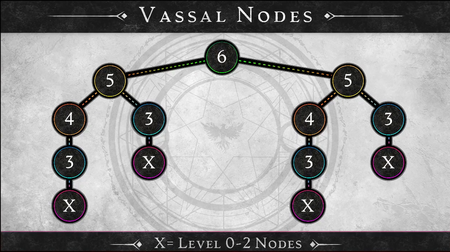
This vassal mode structure tells you what it looks like for a sovereign at a level six metropolis stage; and what it can control at a maximum vassal network is two level five nodes, of which a level five node can control one level four and one level three as direct vassals; and then the four can control a three; and every three can control a one or a two. Now if the three gets removed through siege, the one or the two is removed as well. So that's an important distinction between the three's vassals, which technically isn't really a vassal relationship because there's no citizenships possible. Those vassals don't exist between three and X, but they do exist between four and three, five and four, and six and five. And what this also allows is that because there are 85 nodes that are within the world, we have a buffer zone of about 20 nodes that lives in a max server state. So if you had maximum five metropolises form in a world, you will have a number about 20 nodes that can live alongside those metropolis networks; and when or if a metropolis falls, that extra cushion of nodes around the five metropolis structures allows for the map to be redistricted in a way that is unique. It doesn't mean that one of the fives is just going to pick up where the last six left off and form the same exact metropolis structure. From a territory perspective it has ancillary nodes to play with and expand towards that redistricts the map, so that if a metropolis falls there's a significant difference in the layout of the world and the layout of these almost nation-like territories.[25] – Steven Sharif
Village (stage 3) or higher nodes enslave nearby nodes, converting them into vassal nodes.[2][19]
- A מטרופולין (שלב 6) can control up to two עיר (שלב 5) nodes. A עיר (שלב 5) can control one עיירה (שלב 4) and one כפר (שלב 3) node. A כפר (שלב 3) can control an מחנה (שלב 2) or an משלחת (שלב 1). If the כפר (שלב 3) gets destroyed through a siege, its dependant מחנה (שלב 2) and משלחת (שלב 1) nodes are also destroyed.[25]
- There is a layer of intricacy between how the neighboring nodes advance and what potential parent structure they have in the vassalship tree.[26] – Steven Sharif
- Vassal nodes gain benefits from their regent node (also referred to as sovereign node or parent node) even if the node type of the parent is different to the vassal.[27][28]
- It is not a bad thing to be vasseled, it is a good thing to be vasseled. It brings many benefits from the Sovereign, which is the ultimate parent of that vassal network down to the vassal node itself; and it allows that vassal node to even live outside of its normal mechanics. You get to adopt some of the benefits that the node type of your sovereign is, even if your node type as a vassal node isn't the same.[28] – Steven Sharif
- Regent nodes collect taxes from their vassal nodes. These taxes cannot be taken by the mayor or other players.[30]
- Vassal nodes must remain at least one node stage below their parent node.[2]
- Neighboring/Adjacent nodes from משלחת (שלב 1) upward block the growth of their immediate neighbors. This was intended to be tested in אלפא-1.[18][19]
- Vassal nodes first apply any experience earned to their own deficit (see התנוונות של צומת). It then applies excess experience earned to its parent node.[10]
- If the parent node advances, the vassal is once again able to advance.[2]
- Vassal nodes give excess experience to their parent node and may have their own vassals; so long as they fall within the parent node’s zone of influence.[30][2]
- If a node is capped and is both a vassal and has its own vassals, any experience earned from itself or its Vassals is first applied to its own deficit. Experience beyond that is then sent to its parent node.[10]
- When the vassal reaches its cap it overflows experience up to the parent; and so it can be very good early on for parents to get vassal nodes that are very productive- that have a lot of traffic.[30] – Steven Sharif
- Vassals are subject to the government, alliances, wars, taxes, and trade of their parent node, and are able to receive federal aid from them.[2]
- Vassal nodes cannot declare war on their parent node or any of their vassals.[2]
- Citizens of vassals are bound by the diplomatic states of the parent node.[2]
- If a Node is a Vassal Node and is capped from advancing further, it first applies any experience earned to its own deficit (see Node Atrophy section), and then applies excess experience earned to its Parent Node. If the Parent Node advances and the Vassal is able to grow, it becomes uncapped. If a Node is capped and is both a Vassal and has its own Vassals, any experience earned from itself or its Vassals is first applied to their own deficit. Any experience beyond that is then sent to its Parent Node.[10] – Margaret Krohn
Zones and progression
מבוכים, פשיטות, בוסים עולמיים, Mobs, משימות, אירועים, משאבים, Narratives and other content within a node's אזור השפעה will have a diverse level range; but will scale with the advancement of that node and its racial influence.[31][32][2]
- Portions of the spawn tables (for mobs and resources) are static and other portions are dynamic and adapt to node development.[33]
- We don’t have a strictly level 25 zone. Instead, that zone might have some level 10 creatures near the road, some level 20 creatures deep in the forest, and some level 30 creatures up the mountain. These ratios will change based on the Nodes that inform them, becoming generally more dangerous as the Node grows. All this civilization attracts the attention of Things-That-Should-Not-Be. This does not mean that wilderness areas are safe, by any means. Some may be safe-er, but all will have dangers that even the most experienced traveler needs to watch out for.[34] – Steven Sharif
מנהל העולם
The מנהל העולם is an algorithm in Ashes of Creation that controls dynamic world elements. It acts as both a throttle and an incentive system for various activities to ensure certain parameters are within acceptable thresholds.[35]
- A world manager is a technical term to define a server process that lives alongside the game server; and when the game server needs to do things- communicating with other game servers within that grid- it tells that manager and that manager sends it down to the appropriate server.[36] – Steven Sharif
- Prices of glint.[37]
- A heatmap of experience being gained to apply to node advancement.[37]
- The territory expansion algorithm takes into account the nearest coast, neighboring nodes, and the heatmap of players in surrounding areas over the last weeks or month.[20]
- Due to the way the progression algorithm calculates territorial (אזור השפעה) expansion during node advancement, there is a small possibility that two nodes of the same stage end up being close to each other.[21]
- Transit of resources and goods between regions to drive quest rewards for nodes.[37]
- For example if you know iron is being used as a raw resource for a specific crafting path that might drive up the price of mithril or silver; and that will incentivize the market to course correct a little bit. The idea is to provide soft incentives that help to alleviate the demand and also to prop up the supply that might not be present from the economic systems.[37] – Steven Sharif
Underrealm nodes
Underrealm nodes and nodes directly above them are considered adjacent but do not exist in the same אזור השפעה.[6][7][8]
- There will be "bleed over" between underrealm nodes and surface nodes in terms of influence and interaction.[7]
- There may be visual cues above ground that indicate influence from underrealm nodes in that area.[7]
That might be a little bit of a departure from our design in the past. I know originally like two-plus years ago we were discussing how those would be independent of each other, but I think as we further defined the layout of the world map itself it made more sense for those to have some interaction and influence that's combined.[7] – Steven Sharif
- Caravan routes will go underground.[38]
- מצור על צומת occur in the usual manner.[39]
- There will be underrealm מטרופולינים.[40]
Castle regions
טירות של גילדות influence a castle region around them.[41]
- A castle's region is 1/5th the game world.[42]
- Castle regions, Economic regions, and Node אזור השפעה (Zones of Influence) can overlap.[43][44]
- A castle could have a metropolis beside it.[45]
- Castle region boundaries are static.[43]
- Guild castles impose a tax on all revenue for the nodes within its region.[46][47]
Node simulation
This representation does show 111 nodes as part of this particular simulation. I'm not sure what the tick frequency is on this video. It might be something on the magnitude of like every second is probably 12 to 24 hours. So over time you start seeing these larger node systems building up to eventually where you might see Cities and Metropolises after some period of time; and what this allows the design team to do from a tools perspective, as they simulate this idea of how the world is going to progress, is it gives an opportunity to see strange happenings or something that we couldn't necessarily predict but was a possible outcome based on the variables present.[48] – Steven Sharif
The developers have created a simulation of node interactions in preparation for אלפא-2 deployment of the node system.[48]
- This simulates how nodes advance and expand their zones of influence over surrounding nodes.[48]
You can show the initial territories on the Verran map of what these particular nodes have governance over, or their Zones of Influence as we like to call them... As the simulation of this begins to advance and nodes begin to expand their territory and they begin to take over nearby nodes as a result of their of their growth, you start to see these power level ratings that are applied here on specific nodes that determines what type of takeover power it has and and what it pushes back against for other nodes that are looking to take over new territory as they advance.[48] – Steven Sharif
- It also simulates events, such as דמויות ללא שחקן attacking and disabling certain node buildings and services. Failure to successfully respond to these will reduce the node's "health ticker", which will slow down the XP gains from the node.[48]
It also simulates events: So each of these nodes will have a health ticker: when that health ticker is impacted it'll stop gaining power or gaining or slow down in its gaining of experience; and that's because certain events can affect a node by disabling certain services, disabling buildings. Players don't respond to that horde of zombies that have come out of the nearby ravine then those zombies can attack stables, they can attack service buildings, and prevent particular types of quests or activities and services from happening until it's repaired.[48] – Steven Sharif
- מצור על צומת are simulated, with successful sieges destroying the nodes, and where unsuccessful sieges won't destroy the node but may result in disabled buildings or services, similar to events.[48]
It simulates the sieges if a particular node has a certain frequency that's set where we want to see randomization of how nodes get affected by sieges. Sometimes they'll be destroyed in the simulation. Sometimes they'll have disabled services again, similar to an event, because they didn't succeed necessarily at sieging the node but they did succeed at disabling some of the buildings as part of that siege.[48] – Steven Sharif
- It simulates what outcomes may happen in the live game as a result of player activity, such as splitting up a particular אזור השפעה across a waterway, or having territories expand out to islands or across continents.[48]
It simulates what players could potentially do as well when the game goes live; and that might include things like splitting up a particular Zone of Influence across a waterway, having your territory expand out to an island, or across continents. These are these are the types of things that we want to see players do eventually obviously but this tool provides the design team the opportunity to see it repetitively and over a fast period of time so they see these different types of outcomes.[48] – Steven Sharif
World size
1,200 km2 (square kilometers) is the expected total world size of Verra at launch, including land (480 km2) and water/ocean (750 km2), but excluding the size of the העולם התחתון.[49]
- This has increased from the previously stated total size of 480 km2 including land and water/ocean[50][51][52]; but excluding an additional ~100 km2 of העולם התחתון.[53]
- The Underrealm did not increase "too much" in size.[54]
- The reason given for expanding the map size was to better accommodate פעילות ימית content and to reduce the overall content density in the world.[49]
- The purpose of it becoming bigger is as I said to make sure that density isn't overwhelming: that it isn't everywhere I look there is immediately something. I have no opportunity to see areas of the world that are expansive and are just wanderlust adventure feeling. Everything was sitting on top of you, POIs and nodes and houses and everything. It was like an urban area everywhere. But we wanted to expand that because a large portion of the game is a sandbox element; it's coupled with a lot of curated content but it's that sandbox element.[49] – Steven Sharif
- The shape of the continents has also changed and two new large islands have been introduced.[49]
See also
הפניות
- ↑ 1.0 1.1 1.2 Node series part I
- ↑ 2.00 2.01 2.02 2.03 2.04 2.05 2.06 2.07 2.08 2.09 2.10 Blog - Know Your Nodes - The Basics.
- ↑ רֵאָיוֹן, 2018-04-20 (7:22).
- ↑ Ashes of Creation FAQ.
- ↑ 5.0 5.1 שידור חי, 2018-07-09 (39:32).
- ↑ 6.0 6.1 שידור חי, 2019-03-29 (58:14).
- ↑ 7.0 7.1 7.2 7.3 7.4 שידור חי, 2019-03-29 (29:17).
- ↑ 8.0 8.1 שידור חי, 2017-05-05 (37:52).
- ↑ רֵאָיוֹן, 2018-05-11 (55:16).
- ↑ 10.0 10.1 10.2 10.3 10.4 10.5 Blog - Know Your Nodes - Advance and Destroy.
- ↑ 11.0 11.1 11.2 A reactive world - Nodes.
- ↑ שידור חי, 2018-12-12 (14:48).
- ↑ רֵאָיוֹן, 2020-07-20 (3:45).
- ↑ וִידֵאוֹ, 2017-04-20 (0:02).
- ↑
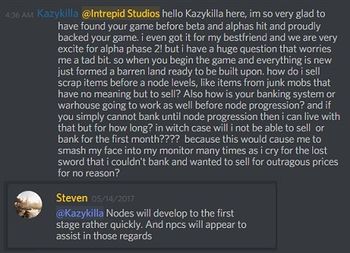
- ↑ Node series part II – the Metropolis.
- ↑ 17.0 17.1 שידור חי, 2017-10-16 (50:20).
- ↑ 18.0 18.1 18.2

- ↑ 19.0 19.1 19.2 19.3

- ↑ 20.0 20.1 20.2 רֵאָיוֹן, 2020-07-18 (10:04).
- ↑ 21.0 21.1 21.2 רֵאָיוֹן, 2020-07-08 (1:00:15).
- ↑ שידור חי, 2017-11-17 (55:27).
- ↑

- ↑ 24.0 24.1 שידור חי, 2017-05-26 (28:16).
- ↑ 25.0 25.1 25.2 25.3 שידור חי, 2022-08-26 (1:07:34).
- ↑

- ↑ שידור חי, 2023-08-31 (52:56).
- ↑ 28.0 28.1 שידור חי, 2022-08-26 (1:04:35).
- ↑

- ↑ 30.0 30.1 30.2 שידור חי, 2022-08-26 (1:10:16).
- ↑ רֵאָיוֹן, 2020-07-19 (19:35).
- ↑ שידור חי, 2017-05-15 (30:53).
- ↑ שידור חי, 2022-08-26 (1:28:50).
- ↑ Interview: Ashes of Creation on Building Their Virtual World, 2017-04-13.
- ↑ רֵאָיוֹן, 2020-07-19 (1:10:55).
- ↑ שידור חי, 2022-10-14 (57:22).
- ↑ 37.0 37.1 37.2 37.3 רֵאָיוֹן, 2020-07-19 (1:08:22).
- ↑ שידור חי, 2017-05-26 (31:44).
- ↑ שידור חי, 2017-05-26 (42:45).
- ↑ שידור חי, 2017-05-24 (31:39).
- ↑

- ↑

- ↑ 43.0 43.1

- ↑
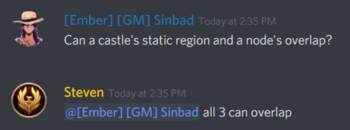
- ↑
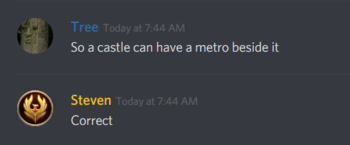
- ↑ שידור חי, 2021-04-30 (1:01:10).
- ↑

- ↑ 48.00 48.01 48.02 48.03 48.04 48.05 48.06 48.07 48.08 48.09 48.10 שידור חי, 2021-09-24 (30:26).
- ↑ 49.0 49.1 49.2 49.3 שידור חי, 2022-08-26 (46:52).
- ↑ שידור חי, 2020-01-30 (1:18:12).
- ↑

- ↑

- ↑ רֵאָיוֹן, 2018-08-17 (10:43).
- ↑ שידור חי, 2023-04-07 (22:48).
